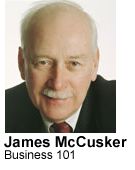 |
Published March 2001
Maximum profit point handy info to know
 A
friend of mine went into the restaurant business a few years back and
recently sent me — via e-mail, of course — a “help me out here” request.
He said he remembered his economics classes had mentioned something about
calculating the maximum profit point, but he couldn’t quite remember how
to do it.
A
friend of mine went into the restaurant business a few years back and
recently sent me — via e-mail, of course — a “help me out here” request.
He said he remembered his economics classes had mentioned something about
calculating the maximum profit point, but he couldn’t quite remember how
to do it.
It’s not surprising he couldn’t recall it, for there was probably very little to remember. Few economics classes spend much time translating theory into practice. And what seemed so elegant and simple in school can be baffling when everyone has gone home and you are sitting in an empty restaurant with a pencil, a calculator, and a pile of bills, reports and financial statements.
Fortunately, though, the economic principle underlying profit maximization is pretty straightforward. For any business, the maximum profitability point is where marginal revenue equals marginal cost.
Why is that? Because each unit of product or service you sell costs you money and brings in revenue. If your prices are constant, as they are in a restaurant, for example, but costs are rising, each sale brings in less and less profit. Eventually, you will reach a point where the last unit you sell brings in revenue just equal to what it cost to deliver it to the customer, and the marginal profit is zero.
Profit is then as big as it ever will be (its maximum), and any sales beyond that point would reduce total profit because the cost of each meal exceeds the revenue it brings in.
Applying that principle to a restaurant means you won’t have those wonderfully pure quadratic cost curves and clean demand functions that populate the textbooks and classroom chalkboards. Instead, you’ll have to use a technique promoted by William of Occam and, later, Henry Thoreau. It’s called “simplify.”
The beauty of the restaurant question is that we simply have to find how many meals should be served in order to maximize the establishment’s profits. And we can get at that by finding out the things we don’t have to worry about and dropping them from the problem.
To start with, unless you let your customers negotiate the price of the burritos or the deluxe seafood salad, your marginal revenue is a constant amount equal to the price of the meal. So, we don’t have to worry about it. It is what it is.
The maximum profit question, then, really comes down to one of “hours,” because the number of meals served usually depends on how long the restaurant is open. And we can concentrate on the labor cost per hour because so many of the restaurant’s costs actually do not vary much at the margin. The food-cost components of the meals, for example, don’t really change that much between the 39th “ling cod special” and the 40th.
It also is true that the rent, the cost of the kitchen equipment, etc. are pretty well fixed, too, so we don’t have to worry about them, either. What does vary is the cost of labor. It would not seem to, at first, because, barring overtime, the rate per hour doesn’t change. But it is transformed into a changing marginal cost because of the nature of restaurant work.
The maximum number of meals a restaurant’s kitchen and wait-staff members can serve in an hour, say, is determined by human factors (you can only move so fast), by the supporting systems and, most importantly, by the restaurant’s layout and “level of service” — how much personal attention customers receive.
At capacity, then, the average labor cost of a meal is the total labor bill — the cooks and the wait staff — divided by the number of meals. At some point in the day, though, because the restaurant isn’t as crowded, instead of dividing a waiter’s labor cost by, say, 24 meals per hour, now you are dividing it by 12, and that applies also to the cook and the hostess.
This makes the average labor cost per meal go up and drives up marginal cost. At some point, it will, when added to the food costs and other variable costs, just equal the menu price of the meal.
At that point, the restaurant cannot make more money by serving more meals. In fact, its profits will decline if it does so.
While this maximum profit point is mathematically precise, the restaurant may find there are practical reasons to stay open fewer, or more, hours than the math would indicate, depending on marketing and the practical aspects of staffing. Knowing where that maximum profit point is, though, is a handy tool for good management.
EDITOR’S NOTE: If you would like a copy of the “restaurant example” showing how to calculate the maximum profit point, you may obtain one by contacting James McCusker via e-mail to otisrep@aol.com.
James McCusker, a Bothell economist, educator and small-business consultant, writes "Your Business" in The Herald each Sunday. He can be reached by e-mail to otisrep@aol.com.
The
Marketplace
Heraldnet
The
Enterprise
Traffic
Update
Government/Biz Groups
© The Daily Herald Co., Everett, WA
